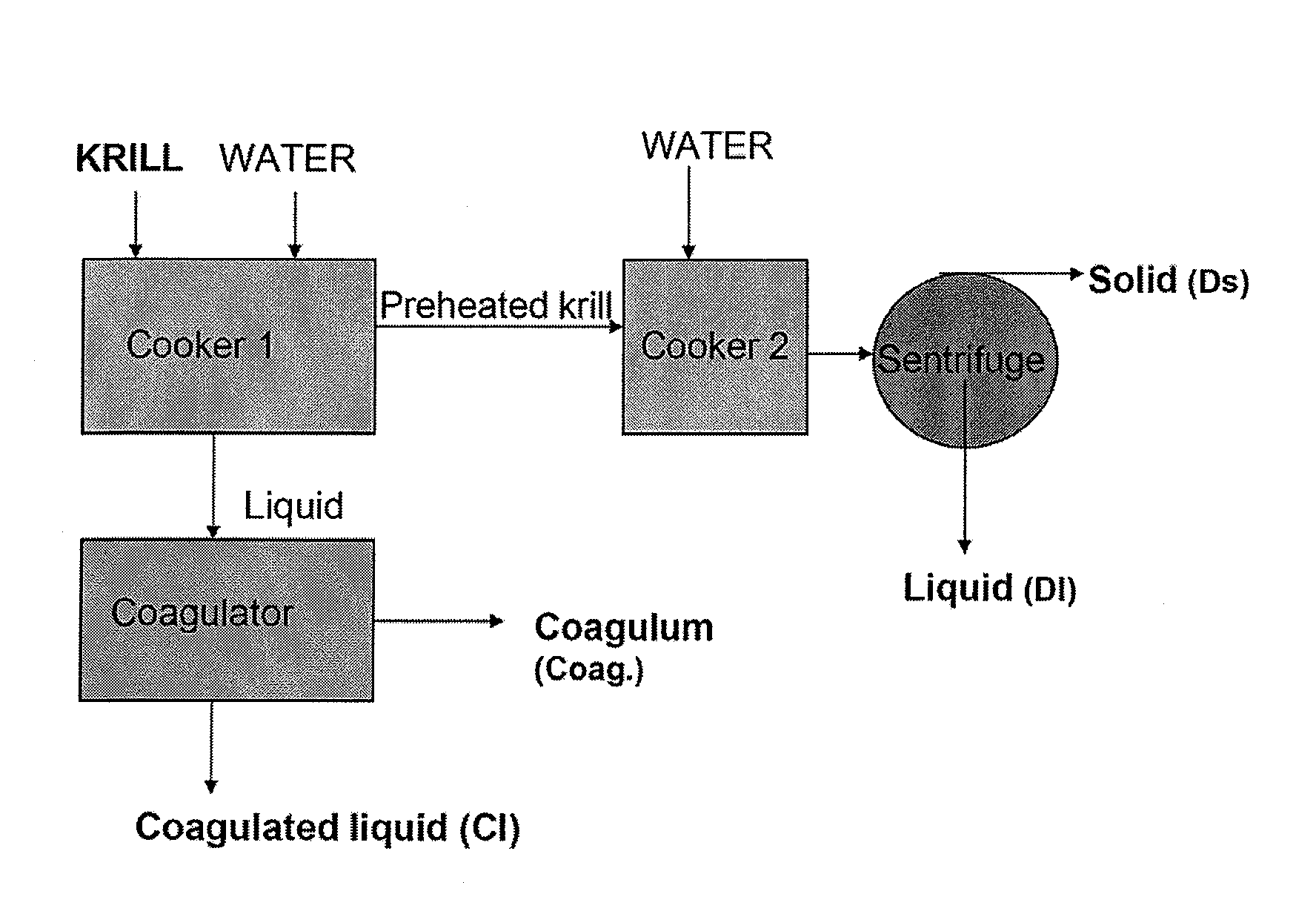Low viscosity phospholipid compositions
a phospholipid composition, low viscosity technology, applied in the field of crustacean processing, can solve the problems of slow production of coagulated krill proteins, difficult mechanical separation of water, fat and protein, and limited food supply, and achieve low viscosity, high phospholipid levels, and low viscosity
- Summary
- Abstract
- Description
- Claims
- Application Information
AI Technical Summary
Benefits of technology
Problems solved by technology
Method used
Image
Examples
example 1
[0072]Four portions of krill were analysed for dry matter, fat, and protein. Most of the variation in the composition can be expected to be due to variation in the sampling. To include the effect of variation in storage time after thawing, raw material samples were also taken at different times during the working day. The observed variation in raw material input is inherent in all calculations of fat, dry matter and protein distributions based on the reported examples.
TABLE 1Composition of krill (g / 100 g)Fat freeDry matterFatdry matterProteinKrill 121.407.8013.6011.80Krill 222.137.4714.6612.96Krill 323.787.4416.3414.60Krill 423.077.5515.5213.83Mean22.607.5715.0313.30SD1.040.161.171.20RSD4.6%2.2%7.8%9.0%
example 2
[0073]In this example a novel method for preparing krill meal was investigated. 800 g of preheated water (95-100° C.) and 200 g of frozen krill (0° C.) were mixed in a cooker (cooker 1) at a temperature of 75° C. for 6 minutes. Next, the heated krill and the hot water were separated by filtration. The preheated krill was further cooked (cooker 2) by mixing with 300 g hot water (95° C.) in a kitchen pan and kept at 90° C. for 2 minutes before separation over a sieve (1.0×1.5 mm opening). The heated krill was separated from the liquid and transferred to a food mixer and cut for 10 seconds. The disintegrated hot krill was added back to the hot water and centrifuged at 8600×g (RCF average) for 10 minutes. The supernatant corresponding to a decanter liquid (Dl) was decanted off The liquid from cooking step 1 was heated to 95-100° C. to coagulate the extracted protein. The coagulum was separated over a sieve (1.0×1.5 mm opening) and a weight of 40 g was found. FIG. 1 shows an overview of ...
example 3
[0074]The total volatile nitrogen (TVN), trimethylamine (TMA) and trimethylamine oxide (TMAO) content were determined in the four products from the cooking test in example 2 (Table 2). The krill was fresh when frozen, so no TMA was detected in the products. The results show that TMAO is evenly distributed in the water phase during cooking of krill.
TABLE 2Distribution of total volatile nitrogen (TVN), trimethylamine (TMA) andtrimethylamine oxide (TMAO) in the products from the cooking procedure.Products from test no. 10CoagulumCoagulatedfromcookerDecanterDecanterKrillcookerliquidsolidsliquidSUMWeight (wb)g20097.6711.190.3294.7Dry matterg / 100 g21.414.21.022.20.9Analytical valuesTotal volatilemg N / 100 g81.31.22.31nitrogenTrimetylamine-Nmg N / 100 gTrimetylaminemg N / 100 g10719.213.510.413.1oxid-NQuantitiesTotal volatilemg N15.01.38.52.12.914.8nitrogenTrimetylamine-Nmg N——————Trimetylaminemg N21418.796.09.438.6163oxid-NDistributionTotal volatile% of100%8%57%14%20%99%nitrogeninputTrimetylam...
PUM
| Property | Measurement | Unit |
|---|---|---|
| Temperature | aaaaa | aaaaa |
| Temperature | aaaaa | aaaaa |
| Fraction | aaaaa | aaaaa |
Abstract
Description
Claims
Application Information
 Login to View More
Login to View More - R&D
- Intellectual Property
- Life Sciences
- Materials
- Tech Scout
- Unparalleled Data Quality
- Higher Quality Content
- 60% Fewer Hallucinations
Browse by: Latest US Patents, China's latest patents, Technical Efficacy Thesaurus, Application Domain, Technology Topic, Popular Technical Reports.
© 2025 PatSnap. All rights reserved.Legal|Privacy policy|Modern Slavery Act Transparency Statement|Sitemap|About US| Contact US: help@patsnap.com



